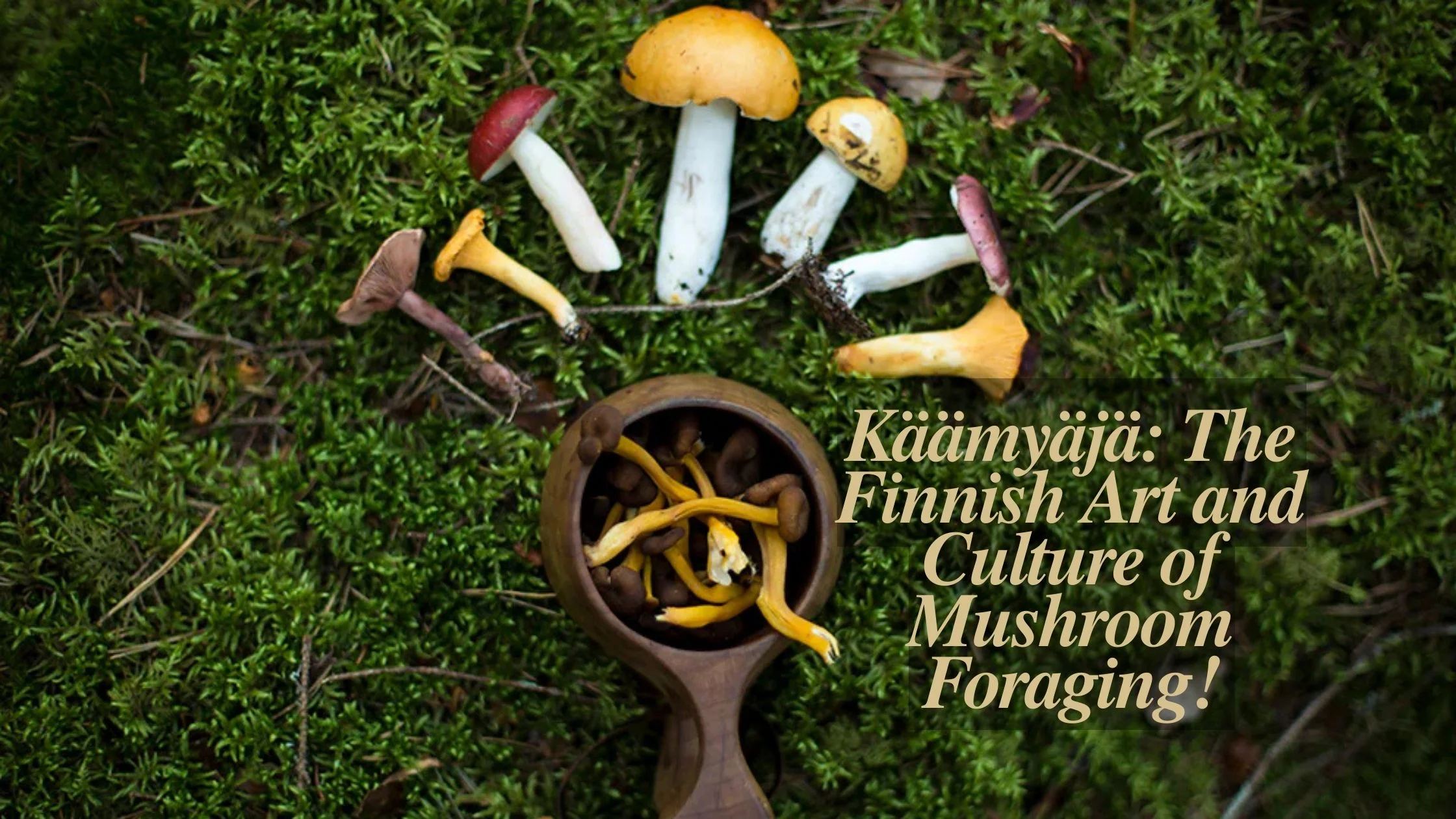Far from being a simple hobby, the art of käämyäjä is an integral part of Finnish identity. It blends food culture, sustainability, and respect for nature.
Mushroom picking, or “käämyäjä” in Finnish, is an age-old tradition deeply rooted in Finland’s cultural heritage.
This article takes a closer look at käämyäjä: its cultural background, importance in Finnish cuisine, and its evolving role in modern life.
The Origins and Meaning of Käämyäjä!
The term käämyäjä combines “käämy” (roughly translated as “cluster”) with “-äjä,” a Finnish suffix indicating someone engaged in a specific activity. Together, it signifies a mushroom picker. But being a käämyäjä is much more than a job description; it’s a tradition that speaks of family bonding, environmental stewardship, and national pride.
Jokamiehenoikeus: “Everyman’s Right”:
In Finland, anyone can roam freely and collect mushrooms, thanks to the unique principle of jokamiehenoikeus, or “everyman’s right.” This right allows individuals to forage without fear of trespassing, as long as they respect nature and avoid damaging private property.
Why Jokamiehenoikeus Matters:
- Encourages outdoor exploration – People can roam freely, promoting a strong connection with nature.
- Sustainable foraging – Foragers are encouraged to take only what they need, protecting the ecosystem.
- Supports traditional practices – This right has kept foraging alive and accessible to all Finns, young and old alike.
The Mushroom-Picking Season!
Finns often anticipate the mushroom-picking season, typically from late summer through early autumn. During this time, forests teem with chanterelles, boletus, black trumpets, and other wild mushrooms.
Family Outings and Seasonal Routines:
Mushroom foraging is not just a solitary activity; it’s often a family event. Parents and grandparents pass on their knowledge of identifying mushrooms, teaching the next generation about the various species, safe foraging, and cooking techniques.
Typical Family Foraging Day:
- Preparation – Foragers gather their baskets, small knives, and brushes for cleaning mushrooms.
- Forest Exploration – Families head out, sharing stories and bonding over the hunt for mushrooms.
- Returning Home – Afterward, families prepare traditional dishes with their fresh finds, such as mushroom soups or creamy sauces.
Identifying Edible Mushrooms!
One of the most important skills of a käämyäjä is the ability to identify safe, edible mushrooms. Misidentification can be dangerous, as some mushrooms are highly toxic.
Common Finnish Mushrooms:
- Chanterelles (Kantarelli) – Recognizable by their golden color and trumpet shape, they’re mild, easy to identify, and versatile in cooking.
- Boletus (Herkkutatti) – Known as porcini, this mushroom has a thick stem and is widely used in risottos and soups.
- Black Trumpet (Mustatorvisieni) – These mushrooms are rich and earthy, often used in gourmet dishes.
- Basket – Traditional woven baskets are lightweight, keep mushrooms fresh, and prevent bruising.
- Small knife – Used to cut mushrooms at the stem, allowing the rest to regrow.
- Brush – Helps remove dirt and debris from mushrooms on-site, reducing cleaning time at home.
Mushroom Foraging and Finnish Cuisine!
For Finns, mushrooms are a key ingredient in many classic dishes, adding earthy flavours to a variety of recipes. Käämyäjä picks mushrooms not only to enjoy fresh produce but also to celebrate Finnish culinary heritage.
Traditional Mushroom Dishes:
- Kantarellikastike (Chanterelle Sauce) – A creamy, savory sauce made with butter, cream, and fresh chanterelles. Typically served over potatoes or with meat.
- Mushroom Soup (Sienikeitto) – A rich soup often made with boletus or chanterelles, perfect for warming up on cool autumn days.
- Marinated Mushrooms – Mushrooms preserved in vinegar and spices, ideal as an appetizer or side dish.
Modern Twists on Classic Recipes:
As Finnish cuisine evolves, chefs are adding modern spins to classic mushroom dishes. Restaurants across Finland now feature mushroom quiches, flatbreads with chanterelle toppings, and even mushroom desserts, emphasizing the versatility of these forest treasures.
Käämyäjä and Finnish Folklore!
The role of the käämyäjä has deep cultural roots in Finnish folklore. Stories about mushroom pickers as mystical figures who could communicate with nature have been passed down through generations.
Mushroom Symbolism in Finnish Culture:
In Finnish folklore, mushrooms symbolize hidden knowledge or luck, appearing overnight as if by magic.
- Wisdom – Some stories suggest that mushroom pickers possess a special understanding of the forest, able to discern its secrets.
- Forest Magic – Mushrooms are believed to be gifts of the forest, revealing themselves only to those who respect nature.
Käämyäjä in Today’s Finland!
In recent years, the tradition of käämyäjä has seen a revival, with more people appreciating the practice for its health benefits, connection to nature and sustainable principles.
Mushroom-Picking Tours and Eco-Tourism:
Finland’s forests are increasingly a destination for eco-tourists who want to experience the joy of foraging first-hand. Guided tours allow visitors to learn safe mushroom-picking techniques, understand different species, and enjoy the culinary experience that comes afterwards.
Highlights of Foraging Tours:
- Educational – Experts teach tourists about safe foraging and species identification.
- Culinary Experience – Many tours end with a mushroom-based meal, celebrating Finland’s flavors.
- Eco-Friendly – Tours encourage sustainable practices and respect for nature, helping preserve the environment.
Social media has played a role in modernizing käämyäjä, with mushroom-picking groups popping up across platforms. These communities allow both novice and expert foragers to share tips, showcase their finds, and post recipes, creating a virtual space for mushroom enthusiasts to connect.
Benefits of Online Communities:
- Knowledge Sharing – Newcomers learn from experienced käämyäjä and avoid dangerous mistakes.
- Community Building – Social platforms bring together mushroom lovers, fostering a sense of unity.
- Inspiration – Members post photos and recipes, inspiring others to explore the forests.
The Health Benefits of Mushroom Picking!
The act of käämyäjä offers several physical and mental health benefits, making it a holistic activity for well-being.
Physical Benefits:
Foraging requires physical movement and encourages spending time in nature, which boosts overall fitness.
- Exercise – Walking, bending, and stretching during foraging improves flexibility and burns calories.
- Fresh Air – Time spent outdoors increases energy levels and boosts immunity.
Mental Benefits:
Mushroom picking is also a calming activity that promotes mental health.
- Stress Relief – The quiet, meditative act of searching for mushrooms reduces stress.
- Mindfulness – Foragers must be present, enhancing focus and mental clarity.
Käämyäjä: Embracing Tradition and Sustainability!
Mushroom picking is not only a pastime but also an eco-friendly activity that aligns with Finland’s focus on sustainability. With practices like sustainable harvesting and avoiding over-picking, käämyäjä are stewards of nature.
Sustainable Foraging Practices:
- Selective Picking – Foragers take only mature mushrooms, allowing others to regrow.
- Respect for Nature – Käämyäjä avoid damaging surrounding vegetation and forest floors.
- Environmental Awareness – Many käämyäjä encourage reforestation efforts, ensuring that future generations can continue foraging.
FAQS:
1. What does käämyäjä mean?
Käämyäjä is a Finnish term for a mushroom picker, specifically someone skilled in foraging wild mushrooms in forests.
2. When is the best time for mushroom picking in Finland?
The peak mushroom-picking season in Finland is from late summer to early autumn, typically August to October.
3. What is jokamiehenoikeus, or “everyman’s right”?
Jokamiehenoikeus allows people to freely roam and forage in nature, as long as they respect the land and its resources.
4. Which mushrooms are popular among Finnish foragers?
Chanterelles, boletus (porcini), and black trumpets are highly sought-after mushrooms in Finland.
5. How do Finnish families participate in käämyäjä?
Families often forage together, teaching younger generations to identify mushrooms and connect with nature.
Conclusion:
Käämyäjä is more than a term; it represents a way of life deeply embedded in Finnish culture. From its role in folklore to its place in modern Finnish cuisine, mushroom picking is an activity that ties the Finnish people to their land, heritage, and each other. As Finns continue to embrace the art of foraging, käämyäjä stands as a testament to the enduring bond between people and nature. Today, käämyäjä is both a beloved tradition and a growing trend, embraced by those who seek a sustainable lifestyle, an appreciation for local food, and a deeper connection with the natural world. Through the practice of käämyäjä, Finns honour the past while looking towards the future, ensuring that the magic of mushroom picking will remain a cherished part of Finnish identity for generations to come.

 Technology4 months ago
Technology4 months ago
 Technology4 months ago
Technology4 months ago
 Business5 months ago
Business5 months ago
 Entertainment3 months ago
Entertainment3 months ago
 Business4 months ago
Business4 months ago
 Business4 months ago
Business4 months ago
 Life Style5 months ago
Life Style5 months ago
 Travel4 months ago
Travel4 months ago


